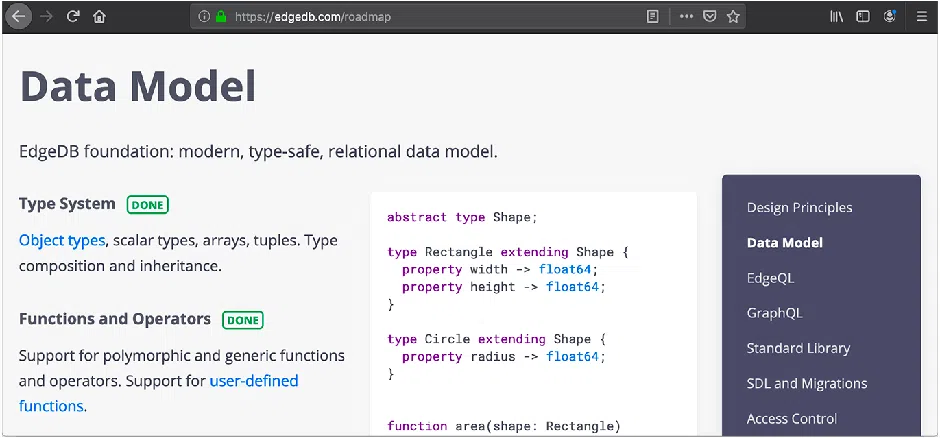EdgeDB is the next generation relational database based on PostgreSQL. It features a novel data model and an advanced query language.
Today we are publishing our product roadmap. It is an overview of what is already implemented and of what to expect in the near future. In the context of that we think it is important to share some of EdgeDB history and reflect on our design approach.
Inception
Some time ago we started as a software agency set out to build great software. Like many, we struggled to balance the desire for good quality with the realities of resource constraints.
During this time we were fortunate to work on many projects across different industries. Naturally we have grown a set of in-house frameworks to help us ship faster and enjoy both the process and the result. The key ingredient of this tooling was the database abstraction and integration layer that allowed us to do awesome things like:
-
Define data access control rules at the schema level, so queries need to only be written once.
-
Use schema introspection and metadata extensively to generate UIs, API endpoints, and data input forms with full data validation.
-
Build a library of reusable schema definitions and queries that can be composed together to implement a variety of common application patterns.
The success of these ideas inspired us to develop them further into what is now EdgeDB.
Mission
The mission of EdgeDB is to give its users more power, freedom and confidence when working with data, whether it’s building services, doing data science, or performing continuous deployment and SRE.
This sounds like a mouthful, so let’s see what this means in terms of some of the features:
-
ability to effectively interface with any host programming language without costly ORMs and other abstractions;
-
efficient emission and ingestion of data in common serialization formats, like JSON or Apache Arrow;
-
ability to interface with clients using common application protocols like REST and GraphQL;
-
support of data and schema security via a centralized, well-defined and easily auditable policy;
-
built-in support for schema migrations and versioning;
-
a large and versatile library of standard types, functions and operators.
We are solving these problems by replacing SQL with a more capable, modern query language, rethinking how the relational database schema is designed, and building a comprehensive set of tools necessary to use the database effectively both in development and in production.
Design Principles
Usability: the effectiveness, efficiency, and satisfaction with which specified users achieve specified goals in particular environments.
ISO 9241 (ergonomics of human-computer interaction)
EdgeDB is developed in accordance to the following principles:
-
Ergonomics
The data model, EdgeQL, and all aspects of EdgeDB operation should be straightforward to learn and reason about, and the user experience should be a satisfying one.
-
Performance
EdgeQL features, language bindings, and tooling should be designed with high performance, low latency operation in mind.
-
Correctness
Correctness should never be sacrificed in favor of ergonomics or performance. Nonsensical operations must always generate an error.
These aspects affect not only the design of the database core and its query language, but also the way the database interacts with client languages, systems and workflows.
Let’s take a look at a few examples.
EdgeDB supports fetching query results as JSON:
>>> ... ... ... ... ...
data = conn.fetchall_json('''
SELECT Movie {
title,
release_year,
}
''')>>>
print(repr(data))'[{"title" : "Blade Runner 2049", "release_year" : 2017},
{"title" : "Dune", "release_year" : 2020}]'The code above returns the entire query result as a single JSON string. Sometimes it’s necessary to fetch data as a sequence of JSON strings for each entry in the result. JSON cast can help:
>>> ... ... ... ... ...
data = conn.fetchall('''
SELECT <json>Movie {
title,
release_year,
}
''')>>>
print(repr(data))Set{'{"title": "Blade Runner 2049", "release_year": 2017}',
'{"title": "Dune", "release_year": 2020}'}Efficient data encoding protocols are one the main reasons why EdgeDB is able to maintain excellent runtime performance.
In situations where an operation may result in surprising behavior, EdgeDB opts to require explicit input.
Exact decimal values and approximate floating point values do not mix implicitly:
edgedb>
select 1.1 + 1.1n;QueryError: operator '+' cannot be applied to operands of type 'std::float64' and 'std::decimal'. Hint: Consider using an explicit type cast or a conversion function.
Datetime values require a timezone to be specified:
edgedb>
SELECT <datetime>'2019-01-01 01:01:01';InvalidValueError: missing required timezone specification
edgedb>
SELECT <datetime>'2019-01-01 01:01:01 US/Pacific';{<datetime>'2019-01-01T09:01:01+00:00'}Computing the mean value of an empty set is an error:
edgedb>
SELECT math::mean(<int64>{});InvalidValueError: invalid input to mean():
not enough elements in input set
### SELECT math::mean(<int64>{});
### ^PostgreSQL happily returns NULL in this case:
postgres=# SELECT avg(a) FROM (SELECT 1 WHERE False) AS q(a);
avg
-----
(1 row)Roadmap

It is hard to capture the entire scope of EdgeDB in a single blog post, so we created the new roadmap page on edgedb.com. It is a live page that the EdgeDB project will use to share the status and the development plans with the community in a presentable format.
Please take a look and tell us what you think!
